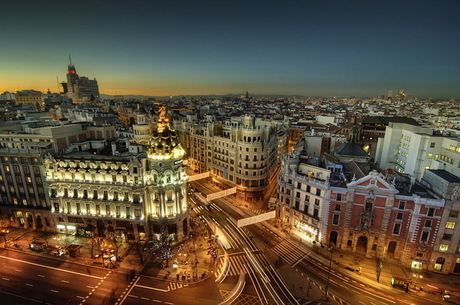Travel Madrid
Madrid is the capital of Spain since 1562. Madrid is located on the geographic center of the Iberian Peninsula. Due to this central location and high altitude, the climate of Madrid is characterized by warm dry summers and cool winters. Madrid is the political center of Spain. This is also a cosmopolitan city with cultural and political importance. Its position as a center for economics, finance, administration and services combines the most modern infrastructure with an important cultural and artistic heritage, the legacy of centuries of fascinating history.
So, while Madrid possesses a modern infrastructure, it has preserved the look and feel of many of its historic neighborhoods and streets. For instance, some of its main historic places are the huge Royal Palace of Madrid; the Teatro Real (Royal theater); the Buen Retiro park; the imposing 19th-century National Library building (founded in 1712); an archeological museum of international reputation; and three superb art museums: Prado Museum, the Museo Nacional Centro de Arte Reina Sofía and the Thyssen-Bornemisza Museum, housed in the renovated Villahermosa Palace.
According to Madrid history, it actually became Spain’s capital mostly because of its location. Around 1561, Philip II wanted a symbol to unify the nation. But he needed somewhere central so communications can be faster. And everything is history since then. What you see now is the lively and modern city.
But Madrid is not just a cultural destination. It is also a lively metropolis with many pubs, cafes, discotheques and nightclubs open late into the night (nobody is really sure when the Madrileños sleep). It may be the afternoon siesta that gives them the endurance to keep things going well into the night. In fact, on weekends, Madrilenian youth are famous for dancing all night long, stopping off only for having some chocolate y churros at dawn, go home, take a shower, shave, and go to work. Madrid has an amazing quantity of dance halls, tascas, cafes, theaters, movie houses, music halls, and nightclubs. However, many of these offerings are strictly for residents or for Spanish-speakers.
After spending much of the 20th century sequestered at the center of a totalitarian regime, Madrid has burst back onto the world stage with an energy redolent of its 16th-century golden age. Beginning in the early 20th century, Madrid grew to be an important industrial center. Its commercial and industrial life developed very rapidly after the 1890s and is rivaled in Spain only by that of Barcelona. The city's major industrial products include motor vehicles, aircraft, chemicals, pharmaceuticals, processed food, printed materials, and leather goods. Besides its many manufacturing industries. Most of its industry is located in the Southern fringe of the city, where important textile, food and metal working factories are clustered.
Especially around Puerta del Sol, you'll find a high concentration of everything relating to food, drinking, entertainment and staying away from your hotels as long as possible. Madrid, during the summer, becomes a virtual free festival because the city sponsors a series of plays, concerts, and films. If you're in Madrid during the second half of May be sure to join Madrileños in celebrating the Feria de San Isidro, which has music, operas, concerts, bullfighting and dancing. In the same way, mid August is when the city celebrates the Verbena de la Paloma.
Aside from being Spain’s capital, Madrid is the third most populated city in Europe. The metropolitan area ranks fourth in population all over Europe as well. You should also take note that the population density in the city is 606 people per square meter. So you should expect crowded places almost everywhere.
There are also so many tourists like you in the city. You will definitely be able to blend in quite easily. The people of Madrid or Madrileños, as they are commonly called, are very welcoming. They also love having a good time with everyone so you will have lots to do during your vacation.
When you get to Madrid you would notice how urbanized the city has become. Nevertheless, they were able to preserve many of their historic districts and structures.
If you’re curious about Madrid’s location, it is actually the center of the Iberian Peninsula. And Madrid is situated 654 meters above sea level. This explains for the cold winters and hot summers you will experience if ever you are in Madrid around this time.
If you want sunny days and more moderate temperatures, you can schedule your trip around the months of September to October when it is autumn season. You would experience the driest season during winter and summer since rainfall is generally felt during autumn and spring only.
If you are going to Madrid on summer, be prepared for the 30 degrees Celsius (or 86 Fahrenheit) to 40 degrees Celsius (or 104 Fahrenheit) temperatures. On the other hand, if you are heading there on winter the temperature is always below 0 degrees Celsius (or 32 Fahrenheit) so prepare to bundle up.
Madrid is served by all the major airline alliances as well as an increasing number of low cost carriers. Madrid's modern airport has recently undergone a major upgrade befitting its status as the 4th busiest in Europe.




